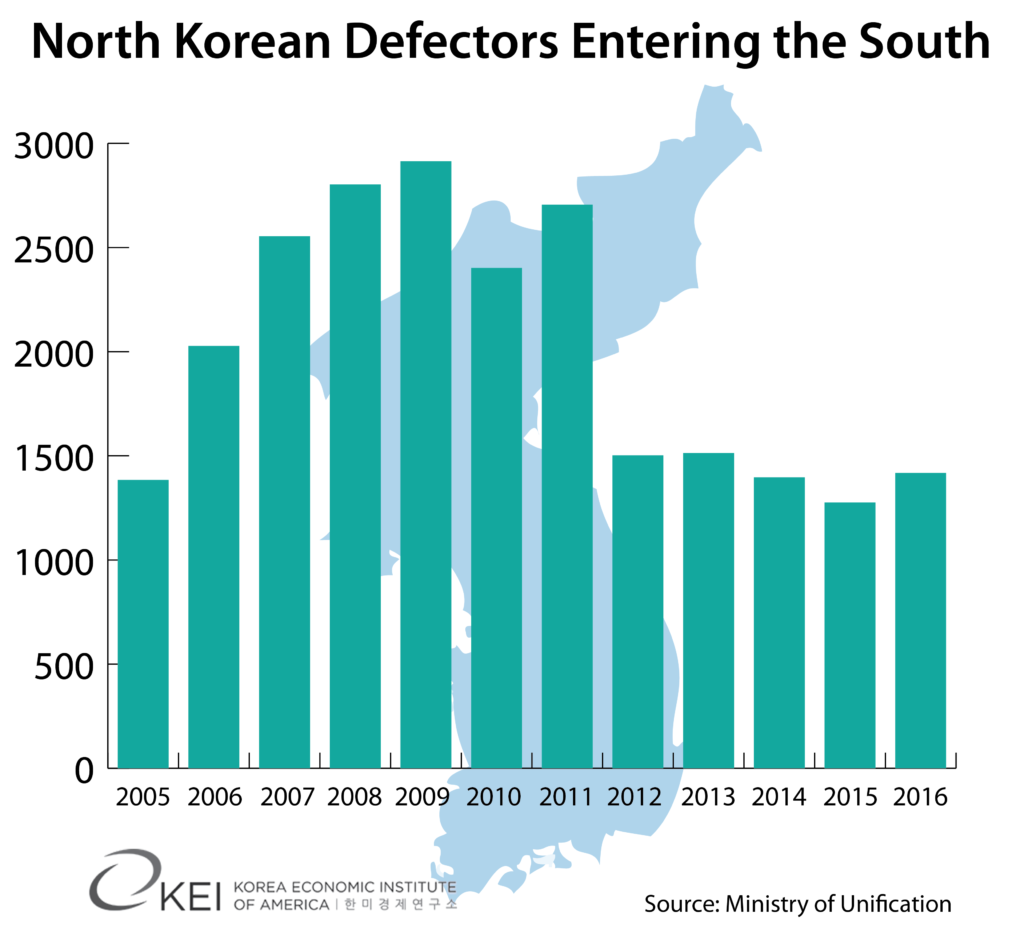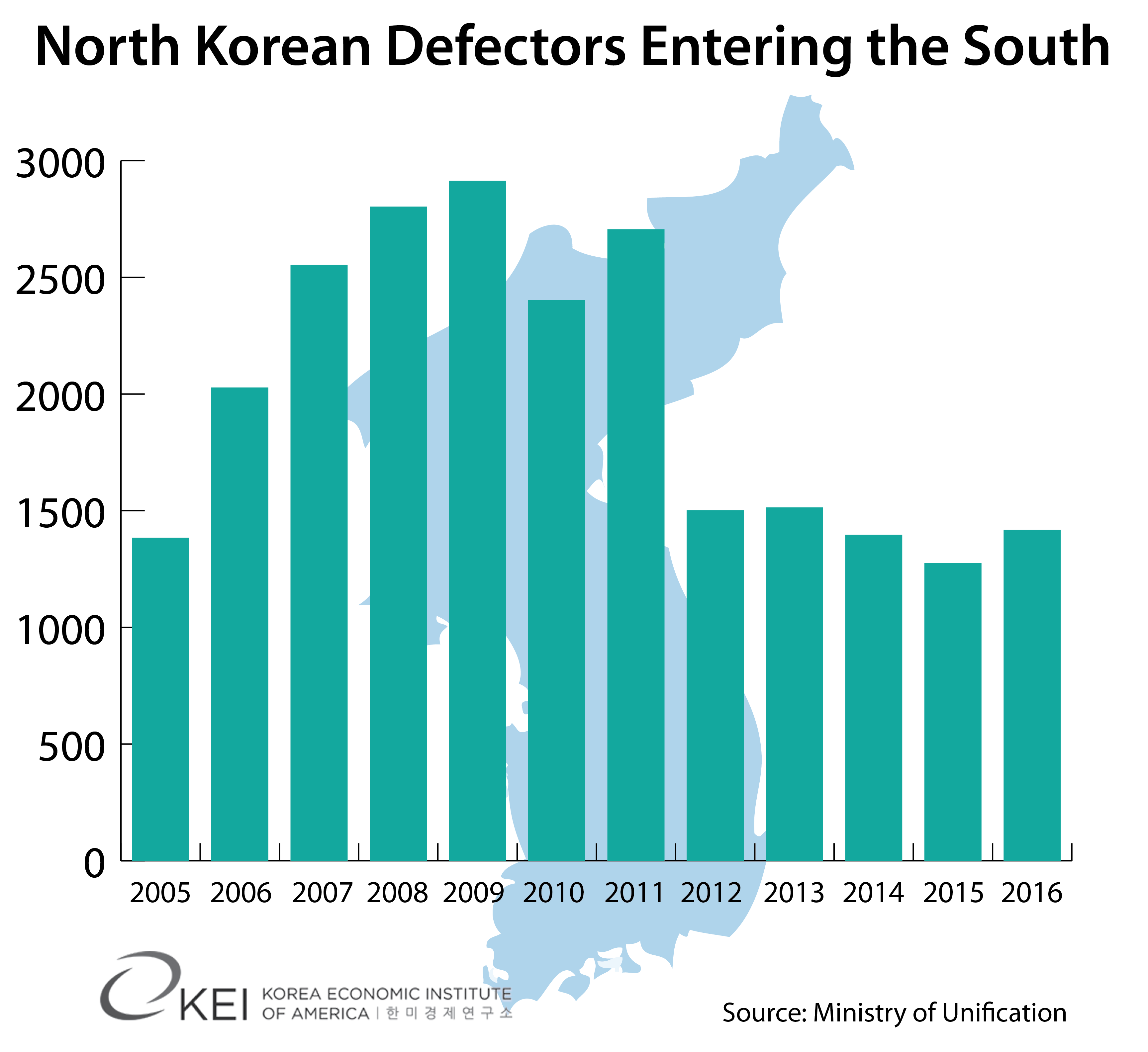The Peninsula
More than North Korean Diplomats Fled to the South in 2016
Published February 22, 2017
Category: North Korea, South Korea

By Patrick Niceforo
Last year, North Korea dominated international headlines with stories about their satellite launch, ballistic missile launches, and two nuclear tests. However, another interesting phenomenon did not receive as much media attention. In 2016, while Thae Yong-ho’s defection from North Korea’s London embassy was widely covered, a total of 1,418 North Korean refugees entered South Korea, an 11.2 percent increase from the year prior and the first time that the number of refugees has gone up since 2013. What is the cause for this increase and what is the primary driver for North Koreans to leave?
The most dramatic shift in recent years occurred between 2011 and 2012 when the number of North Korean refugees entering South Korea fell from 2,706 to 1,502. DPRK watchers have suggested several reasons for this sudden drop including North Korea’s tightened border security, increased propaganda, and overall healthier economy relative to previous years. While it may be too soon to tell if this trend has reversed, the slight increase for 2016 may suggest a shift in defectors’ motivations. Experts have suggested that there is an increase in overall political dissatisfaction and deteriorating loyalty to the Kim regime. In fact, the North Korean government has even had to tighten border security in order to deal with the temporary bursts in defections after events such as flooding and high-profile defections.
Experts have pointed to an increase in certain kinds of North Korean refugees, such as overseas laborers and individuals belonging to the middle-class, as a sign that more people are growing dissatisfied with the regime. In fact, South Korea’s Ministry of Unification concluded that, based on survey results, the number of North Korean defectors who self-identify as “middle-class” has jumped to over 55% after 2014 from 19% before 2001. According to another survey, 90% of defectors stated that living conditions have deteriorated under Kim Jong-un. Also of note is the increase in high-level defections of North Korea’s elite, or at least increased mention of in the media. The data seems to suggest that a mix of political grievances and economic hardship are primary motivators for leaving North Korea as opposed to the famine in North Korea in the 1990s.
With this increase, South Korea is working to improve services for refugees. South Korea’s Ministry of Unification recently issued their Work Plan for 2017 in which they stated that their overall objective was to “Encourage North Korea to denuclearize by making right choices and lay the foundation for a peaceful unification.” Defectors also played a key role in their plans, including strategies to a) carry out follow up measures for social integration policy of North Korean defectors; b) spread consensus on the need for peaceful unification through participation and communication, as well as public-private cooperation; and c) provide unification education in preparation for a unified future.
North Korean refugees have also been prominently featured in the South Korean media recently with a number of biographies and popular television shows such as Now on My Way to Meet You. Whether these programs are explicitly part of a strategy to prepare South Korea for more North Korean refugees is unclear, but they do accomplish two related goals for the Ministry of Unification, promoting sympathy and social integration and undermining the Kim regime’s credibility by highlighting its inability to provide for its people.
Despite the increased exposure to the South Korean public, North Koreans still face many obstacles to assimilation such as gaps in physical health, bullying, and unemployment. Moreover, recent political developments have affected the travel status of North Korean refugees outside the Korean peninsula. Among the tens of thousands of people affected by President Trump’s executive order on travel restrictions is a small, but unspecified number of North Korean refugees. However small, the rising number of North Korean refugees entering South Korea may be a sign that the United States and other countries may likewise receive additional applications for asylum.
Former UN Secretary General Kofi Annan once said, “Freedom from want, freedom from fear and the freedom of future generations to inherit a healthy natural environment – these are the interrelated building blocks of human and therefore national security.” As of 2016, over 30,000 North Koreans have entered South Korea for one reason or another. Although the Kim regime is infamous for its labor camps and nuclear testing, it is the absence of opportunity and certain liberties that seem to be driving people out of North Korea.
Patrick Niceforo is an intern with the Korea Economic Institute and a graduate student at the Middlebury Institute of International Studies. The views expressed here are the author’s alone.

